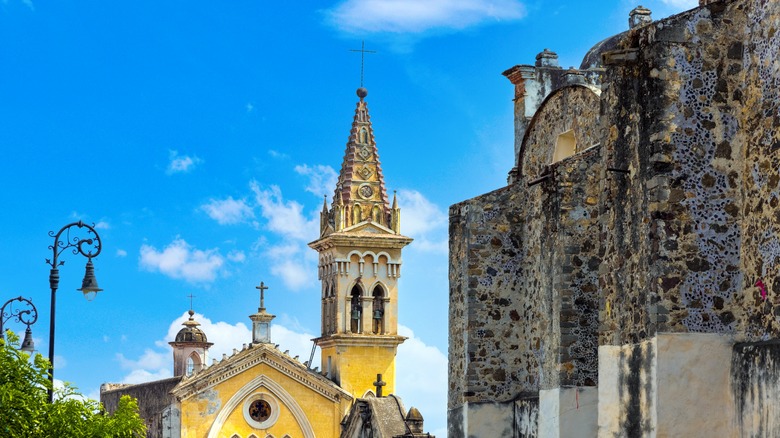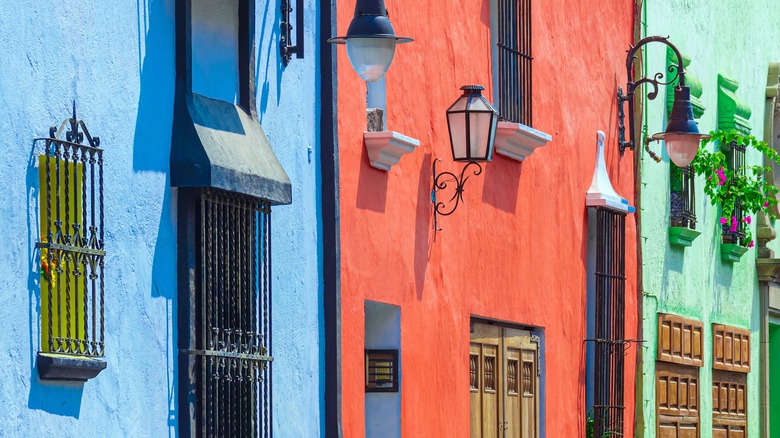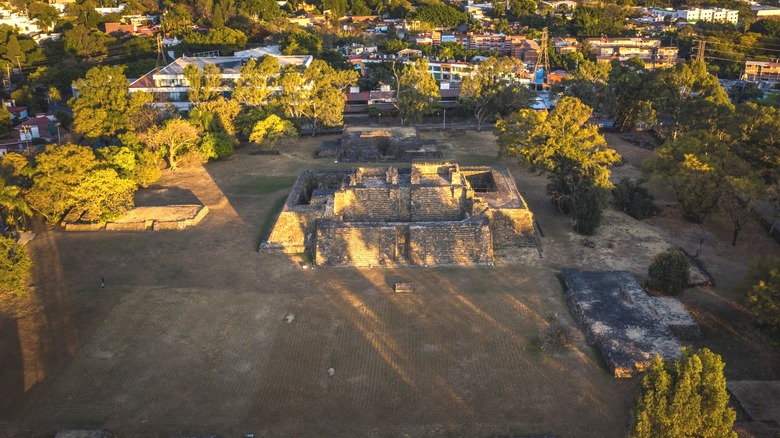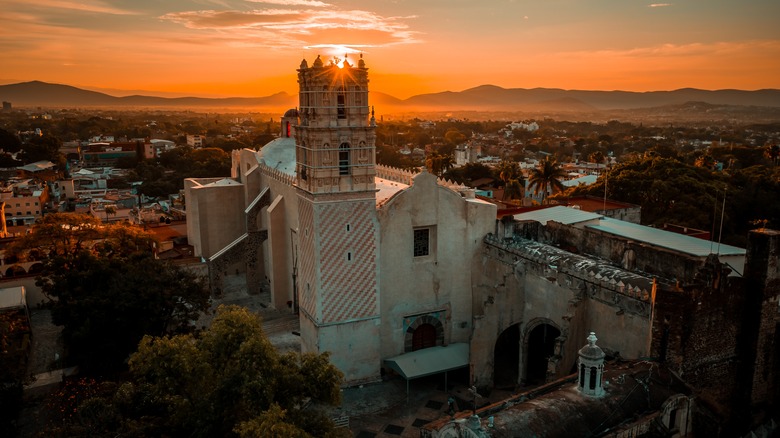The Sunny And Underrated Tourist Destination In Mexico Often Called 'City Of Eternal Spring'
Few foreigners have heard of Cuernavaca, a city of over a million people in central Mexico. After all, Cuernavaca is far from any beach, and there's no hotel zone where all-inclusive travelers can sequester themselves. This place isn't even easy to get to. If you're flying into Mexico City, you'll have to drive two hours southwest along major highways or else hop a bus, which will take even longer. When you think of famous names on the Mexican tourist circuit — Cancún, Tulum, Cabo San Lucas, Oaxaca — Cuernavaca almost never comes up.
So why visit? Because Cuernavaca is a beautiful Colonial city, with elegant churches, pastel-colored houses, and palm trees poking out of rolling hills. The weather is near-perfect much of the year, thanks to its cooling elevation of 5,000-plus feet above sea level. Cuernavaca isn't nearly as large as the nation's capital, which remains one of the most populous cities in the world, but it offers many of the same attractions: a historical center, Aztec ruins, and a wealth of dining and cultural venues. (And it's way less crowded.) There's a lot to see here, which is why Cuernavaca is considered one of Mexico's most underrated tourist destinations.
A Colonial touchstone in the land of eternal spring
Cuernavaca's Colonial roots run deep: The conquistador Gonzalo de Sandoval arrived in this land in the early 16th century to establish sugarcane plantations, followed by waves of Catholic missionaries. As the number of settlers grew, so did the houses and churches that you can still see today in the city's older quarters. The city's anchor point is the Palace of Hernán Cortés, a stone fortress-home with crenellated walls and an imperious clock tower. It was here that Cortés, the Spanish soldier of fortune, spent his final years and raised his young son Martín, who inherited the palace. One of the first European-designed fortifications in the Americas, this structure has served as a domicile, government building, prison, and artisan workshop before ultimately becoming a museum. Today the palace is known as the Museum of Cuauhnahuac, the original Indigenous name for Cuernavaca, and is filled with pre- and post-Columbian artifacts.
Like many old Mexican cities, Cuernavaca has a central plaza called el zócalo, where you'll find the magnificent Cathedral of the Ascension, built in 1525, and the tranquil Borda Garden, which has provided residents with a leafy urban sanctuary since the 17th century; the once-fallow grounds were restored to their original splendor the late 1980s. Vendors sell food and refreshments, and more formal dining is available on surrounding streets. Strolling these old blocks is pleasant most of the year, thanks to Cuernavaca's famous climate; the German naturalist Alexander von Humboldt dubbed this city "The Land of Eternal Spring."
Enduring relics of Indigenous peoples
The story of Cuernavaca long predates the arrival of the Spanish; Indigenous people first built dwellings here around 1200 C.E. Many people use the term "Aztecs" to describe the pre-Columbian nations of Central Mexico, but the people who built Cuauhnahuac are more properly known as the Tlahuicas. Although the conquistadors razed their city and built their own monuments on top of older ones, some Tlahuica architecture remains: The most famous is the Teopanzolco Archaeological Zone, where an ancient stone pyramid still stands in the very center of Cuernavaca. The name Teopanzolco is means "abandoned temple" the Nahuatl language. Across from the site is the Teopanzolco Cultural Center, a beautiful modernist building with a sizable concert hall and rooftop terrace.
The Indigenous people of Cuernavaca suffered terribly under the "hacienda" labor system, and the state of Morelos is famous as the homeland of Emiliano Zapata, a mestizo freedom-fighter who a led a guerrilla resistance during the Mexican Revolution. This remains a heated topic in Morelos, and Zapata continues to inspire Indigenous activists. Tlahuica people, arts, and dress are everywhere in Cuernavaca, and there are many other archaeological sites across Morelos. If you're a history buff, Morelos is one of many places in Mexico you should travel to.
A worthy destination off Mexico's beaten track
You may have to take a little more time to visit Cuernavaca, but the downtown area is saturated in affordable hotels, and Spanish language schools and wellness spas are scattered across the city. While summers can get hot and winters cold — especially at night — the climate is almost idyllic year-round, which largely explains Cuernavaca's sizable expat community. If you're wringing your hands over alarming headlines about crime in Mexico, know that Cuernavaca is not considered a cartel hotspot and you can just exercise the usual precautions. There are many fairs and festivals held throughout the year, including the rambunctious carnival in February.
In short, Cuernavaca is an enriching alternative to the beaches-and-tequila vacations that many visitors arrange in popular coastal cities. You're also close to Mexico City, which has garnered global attention as a fun, action-packed getaway. Curious about what other surprises this dynamic nation has to offer? Mexico's Cascada de Basaseachi National Park may just be one of the most beautiful and underrated in North America.



